
Making the Connection: Trauma and Substance Abuse - Fact Sheet Series for Providers Treating...
Explores links between trauma and substance abuse.
October was first declared as National Substance Abuse Prevention Month in 2011. Since then, October has been a time to highlight the vital role of substance abuse prevention in both individual and community health has, to remember those who have lost their lives to substance abuse, to acknowledge those in recovery, as well as children, parents, family, and friends supporting them. Studies show that the earlier an individual starts smoking, drinking or using other drugs, the greater the likelihood of developing addiction. 9 out of 10 people who abuse or are addicted to nicotine, alcohol or other drugs began using these substances before they were 18. People who began using addictive substances before age 15 are nearly 7 times likelier to develop a substance problem than those who delay first use until age 21 or older. Every year that substance use is delayed during the period of adolescent brain development, the risk of addiction and substance abuse decrease.
The National Child Traumatic Stress Network (NCTSN) has compiled a list of helpful resources for parents and caregivers, children and teens, mental health providers, child welfare workers, law enforcement professionals, educators and school staff, and policy makers.

Explores links between trauma and substance abuse.

Outlines treatment options for youth with traumatic stress who are experiencing substance abuse problems.

Provides statistics about adolescent trauma and substance abuse.

Provides statistics about adolescent trauma and substance abuse.

Offers parents and caregivers whose teen might be or is experiencing substance abuse and/or stress from a traumatic event.

Ofrece a los adolescentes información sobre lo que es el trauma, cómo puede afectarlos y las razones por las que podrían llegar a consumir alcohol o drogas para enfrentar sus experiencias.

Summarizes the signs of intoxication, substance use, and abuse commonly reported by substance users. This guide for parents and caregivers describes different substances teens use, how a teen may look when on that substance, how they may act, and how the substance may make them feel.

Offers information on suicide, self-harm, and substance abuse prevention and treatment. This website promotes treatments that reduce the risk of serious health and behavioral health problems in youth.